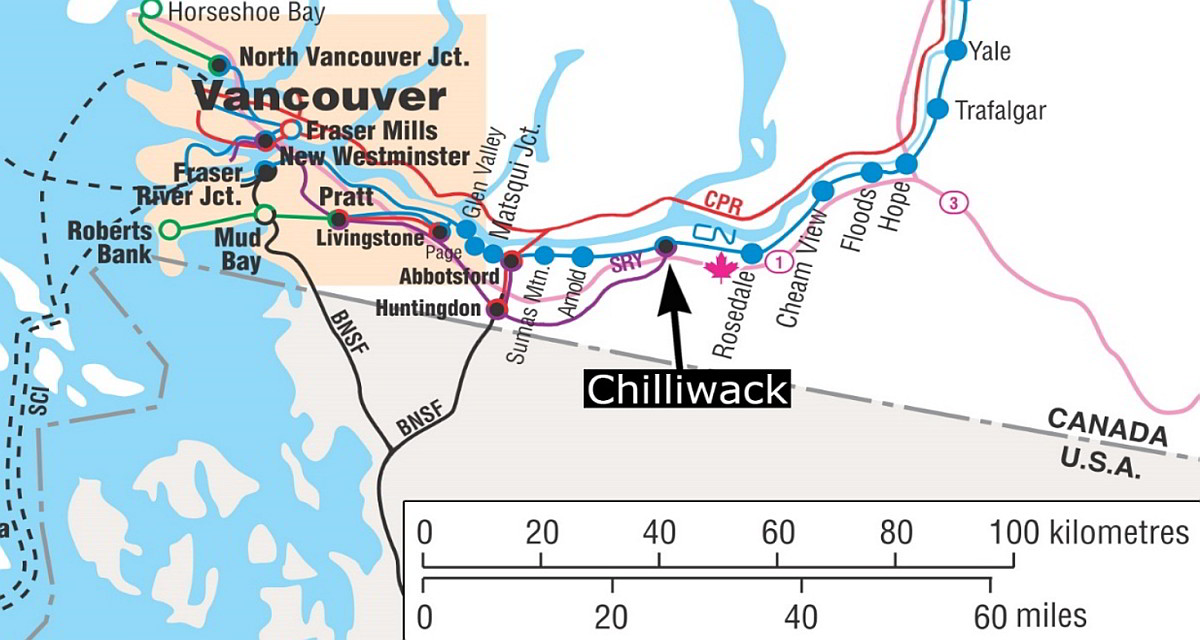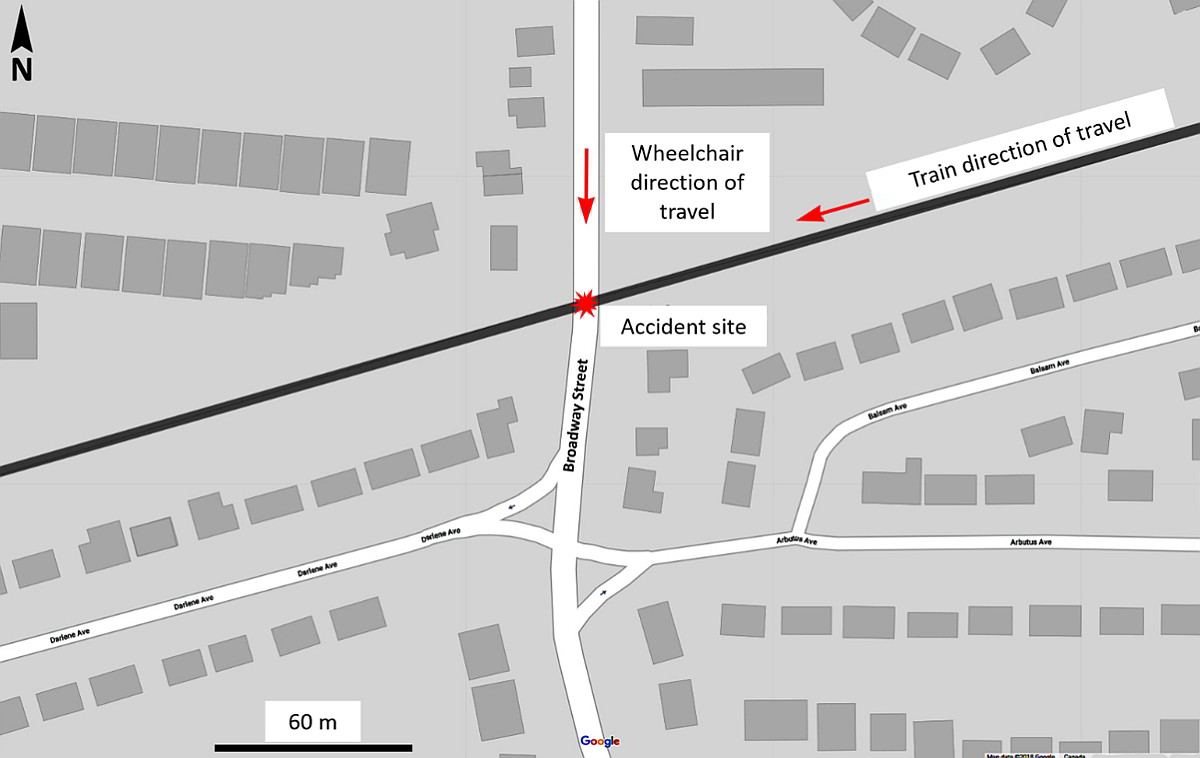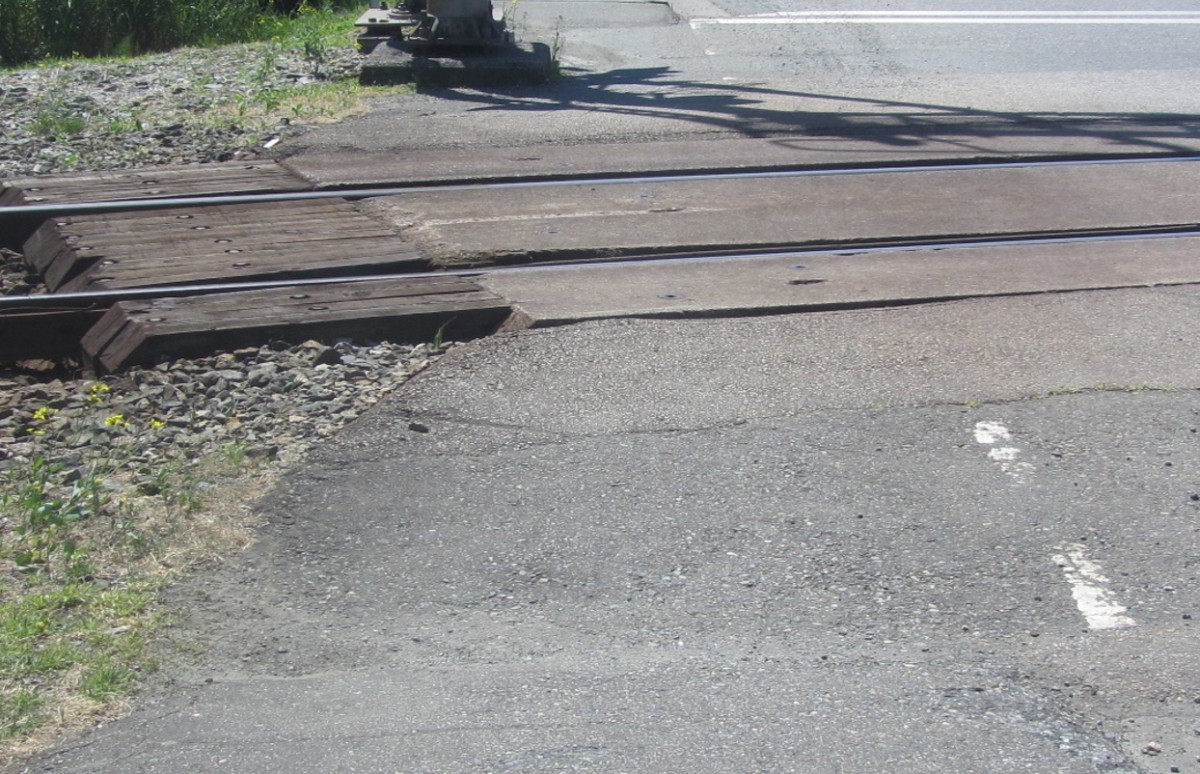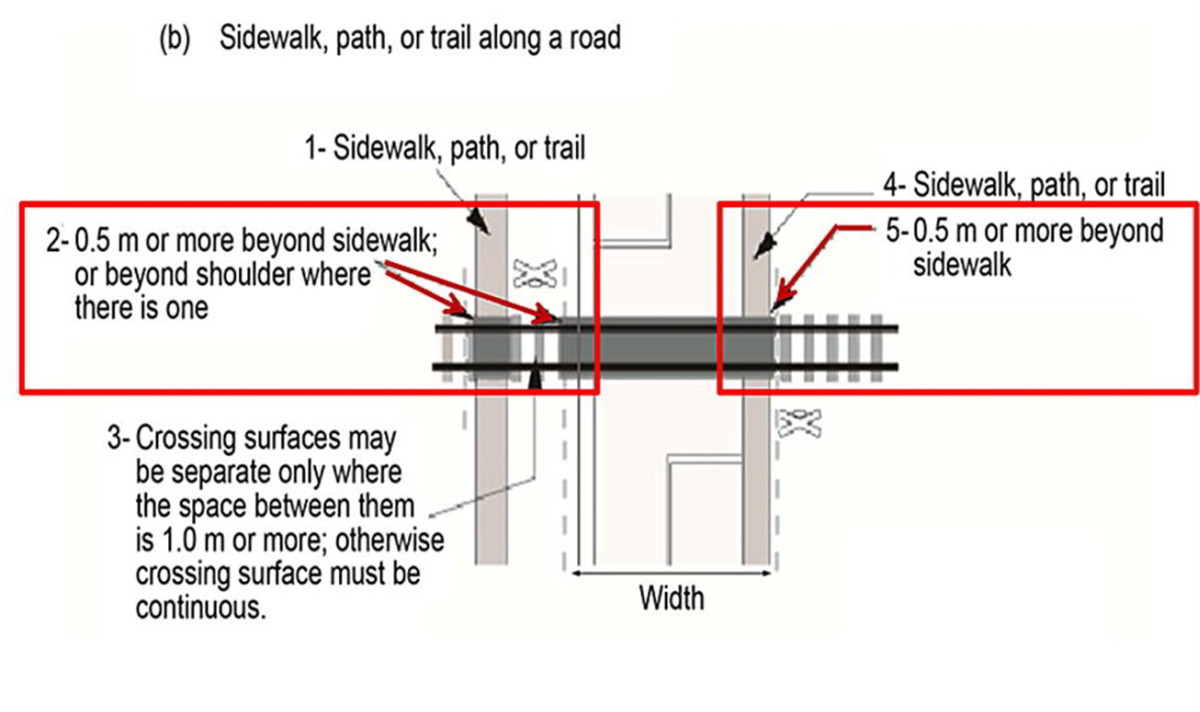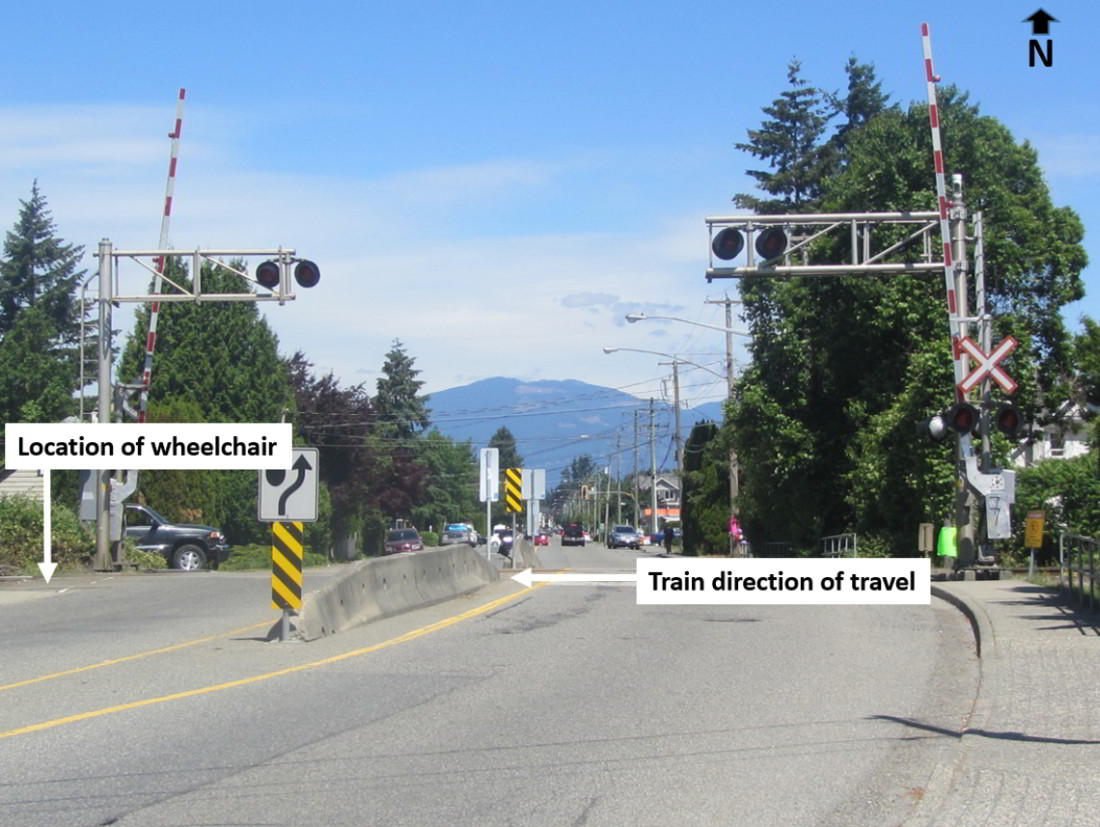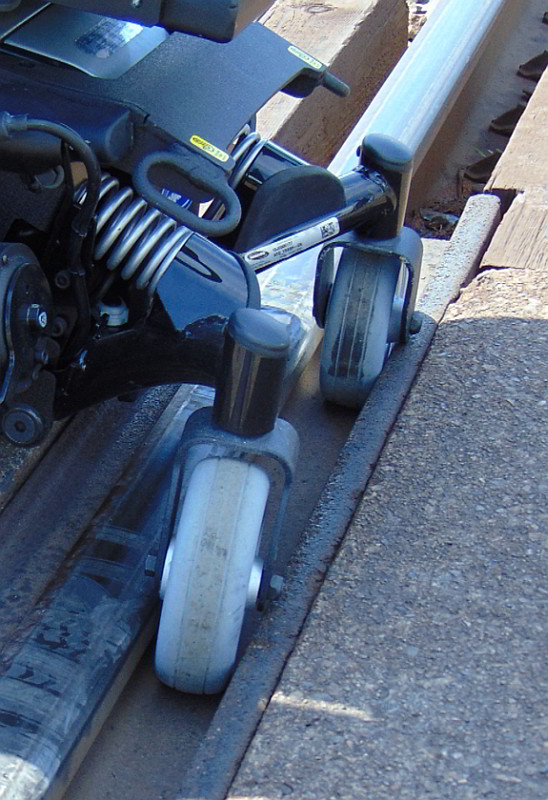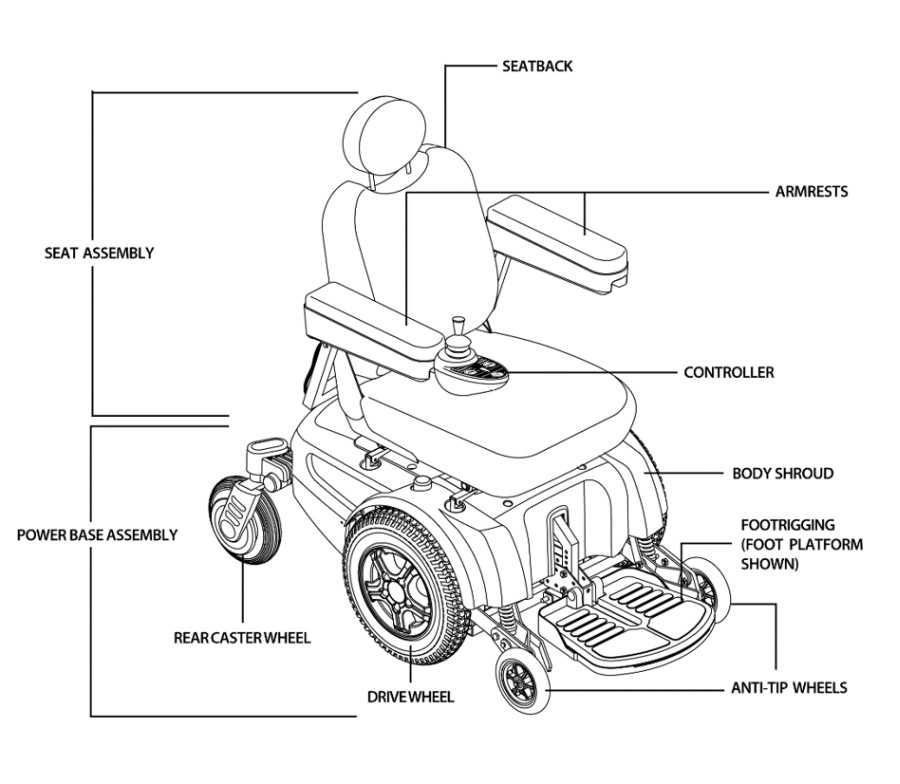Crossing Accident
Canadian National Railway Company
Freight train Q10521-21
Mile 71.13, Yale Subdivision
Chilliwack, British Columbia
The Transportation Safety Board of Canada (TSB) investigated this occurrence for the purpose of advancing transportation safety. It is not the function of the Board to assign fault or determine civil or criminal liability. This report is not created for use in the context of legal, disciplinary or other proceedings. See Ownership and use of content. Masculine pronouns and position titles may be used to signify all genders to comply with the Canadian Transportation Accident Investigation and Safety Board Act (S.C. 1989, c. 3).
Summary
On 26 May 2018, at about 1735 Pacific Daylight Time, Canadian National Railway Company (CN) train Q10521-21, travelling westward through Chilliwack, British Columbia, struck and fatally injured a pedestrian in a motorized wheelchair at the Broadway Street public crossing (Mile 71.13 of the Yale Subdivision). The pedestrian’s wheelchair had become immobilized on the crossing. Two motorists, who had stopped at the crossing, exited their vehicles to assist the pedestrian before the collision. One of them was struck by the train and sustained serious injuries.
Factual information
The accident
On 26 May 2018, at around 1735 Pacific Daylight Time,Footnote 1 CN train Q10521-21 was travelling westward at about 47 mph on the Yale Subdivision within the City of Chilliwack, British Columbia (Figure 1). The locomotive headlights were on full power, and the ditch lights were on. The locomotive bell was being activated as the train travelled through a number of public crossings in the area. An anti–whistling bylawFootnote 2 was in effect in the City of Chilliwack for the public crossings located between Mile 70.33 and Mile 73.05Footnote 3 of the Yale Subdivision.
When the train was about ¼ mile from the Broadway Street public crossing (Mile 71.13), the crew observed an object on the track at the crossing. The crew could not initially identify the object, but it soon became apparent that a pedestrianFootnote 4 in a motorized wheelchairFootnote 5 was on the crossing. As the train approached the crossing, the grade crossing warning system activated and the crew began to sound the horn.
Two motorists from 2 southbound vehicles that had stopped at the crossing saw the immobilized wheelchair, exited their vehicles, and attempted to help the pedestrian, but were unable to move the pedestrian to safety in time.Footnote 6 The train, travelling at about 47 mph, struck the immobilized wheelchair (Figure 2). The train brakes were placed into emergency about 7 seconds after the collision. The pedestrian, who was still in the motorized wheelchair, was fatally injured. One of the 2 motorists trying to help the pedestrian was also struck by the train and sustained serious injuries.
Train information
The distributed-power Footnote 7 train consisted of 2 locomotives and 125 loaded cars. A remote-controlled locomotive was positioned at the rear of the train. The train weighed 5589 tons and was 7892 feet long. The train had originated in Montréal, Quebec, and was destined for Vancouver, British Columbia.
The train crew consisted of a locomotive engineer and a conductor. Both crew members were qualified for their positions, familiar with the territory, and met established fitness and rest requirements.
Subdivision information
The Yale Subdivision begins at Mile 0.0 (Boston Bar, British Columbia) and extends to Mile 112.8 (Douglas Island in Surrey, British Columbia). Train movements on this subdivision are governed by the centralized traffic control system, as authorized by the Canadian Rail Operating Rules and supervised by a rail traffic controller located in Edmonton, Alberta. The average daily train traffic is about 40 trains. At the occurrence location, the maximum speed for freight trains is 60 mph.
Recorded information and sequence of events
Information from the locomotive event recorder was examined. A video recording from a fixed camera located on a signal bungalow at the crossing was also reviewed. Based on the recorded information, the sequence of events (Table 1) was established. All times are approximate.
| Time* | Pedestrian in motorized wheelchair | Train | Grade crossing warning system |
|---|---|---|---|
| 1732:50 | Pedestrian travels southward toward the crossing and stops on the sidewalk before the crossing. | At Mile 69.38, travelling at 46.4 mph, the train is about 9240 feet from the crossing. | Not activated |
| 1733:27 | The pedestrian begins to move onto the crossing. | At Mile 69.86, travelling at 46.5 mph, the train is about 6706 feet from the crossing. | Not activated |
| 1733:34 | The pedestrian crosses the north rail, stops between the rails on the west side of the crossing and looks west and then east. | At Mile 69.95, travelling at 46.5 mph, the train is about 6230 feet from the crossing. | Not activated |
| 1734:07** | The pedestrian then proceeds south but stops with the rear wheels on the south rail. | At Mile 70.38, travelling at 46.7 mph, the train is about 3960 feet from the crossing | Not activated |
| 1734:19 | The pedestrian remains on the track, with the rear wheels of the wheelchair on the south rail. | The train is visible from the crossing. | Not activated |
| 1734:26 | The pedestrian moves the motorized wheelchair in the opposite direction, resulting in 1 of the rear caster wheels becoming lodged in the flangeway*** gap of the south rail, immobilizing the wheelchair. Additional movement of the wheelchair results in the 2nd rear wheel becoming lodged in the flangeway gap. The pedestrian attempts to dislodge the wheels with forward body movements. | At Mile 70.63, travelling at 47.1 mph, the train is about 2640 feet from the crossing. | Not activated |
| 1734:28 | The wheelchair is immobilized at the crossing. | At Mile 70.66, travelling at 47.1 mph, the train is about 2480 feet from the crossing. | Signals begin to flash. |
| 1734:34 | The wheelchair is immobilized at the crossing. | At Mile 70.73, travelling at 47.1 mph, the train is about 2110 feet from the crossing. | Crossing gates begin to descend. |
| 1734:45 | The wheelchair is immobilized at the crossing. The pedestrian continues attempts to free the wheelchair. | At Mile 70.88, travelling at 47.2 mph, the train is about 1320 feet from the crossing. | Crossing gates are fully down. |
| 1734:47 | The wheelchair is immobilized at the crossing. | At Mile 70.90, travelling at 47.0 mph, the train is about 1210 feet from the crossing. The locomotive bell is activated. | Crossing gates are fully down. |
| 1734:49 | The wheelchair is immobilized at the crossing. | At Mile 70.93, travelling at 47.2 mph, the train is about 1060 feet from the crossing. The locomotive horn is sounded for 2 short blasts. | Crossing gates are fully down. |
| 1734:56 | The wheelchair is immobilized at the crossing. Two motorists, who had exited their vehicles, attempt to move the pedestrian in the immobilized wheelchair to safety.The 2 motorists lift the 2 rear caster wheels from the flangeway gap but are unable to move the wheelchair. | At Mile 71.02, travelling at 47,0 mph, the train is about 592 feet from the crossing. The locomotive horn is sounded continuously for 2 seconds. | Crossing gates are fully down. |
| 1734:59 | The wheelchair is immobilized at the crossing.The 2 motorists continue their efforts to move the pedestrian to safety. | At Mile 71.06, travelling at 47.0 mph, the train is about 410 feet from the crossing. | Crossing gates are fully down. |
| 1735:01 | The wheelchair is immobilized at the crossing. The 2 motorists continue their efforts to move the pedestrian to safety. | At Mile 71.09, travelling at 47.2 mph, the train is about 280 feet from the crossing. The locomotive horn is sounded continuously for 7 seconds. | Crossing gates are fully down. |
| 1735:04 | The immobilized wheelchair is struck by the train. The 2 motorists attempt to jump out of the path of the train, but 1 of them is struck by the train. | At Mile 71.13, travelling at 47.0 mph, the train arrives at the crossing. | Crossing gates are fully down. |
| 1735:11 | – | At Mile 71.23, travelling at 46.6 mph, the train is placed into emergency braking. Dynamic brake is applied at 92%. | Crossing gates are fully down. |
| 1736:06 | – | At Mile 71.63, the train stops. | Crossing gates are fully down. |
* The time recorded on the locomotive event recorder was 1 minute 47 seconds behind the time recorded by the signal bungalow camera. The event times have been normalized to be consistent with time recorded by the signal bungalow camera.
** This time is approximate; the video playback is interrupted during this period.
*** A flangeway is a space several inches wide and several inches deep, immediately adjacent to the gauge side of each rail at a crossing. The flangeways accommodate the flanges on the railway wheels when a train operates over a crossing.
Broadway Street public crossing
The Broadway Street public crossing is located at Mile 71.13 of the Yale Subdivision. It is equipped with a grade crossing warning system consisting of flashing lights, bell, and gates. The crossing is single track with a concrete crossing surface and wooden ties affixed to either end of the concrete to extend the crossing surface as required under the Grade Crossings Standards (GCS), Part B, section 3.1 (Figure 3).
All sidewalks in the City of Chilliwack are designed for use by persons using assistive devices, including sidewalks at railway crossings. However, in the documents shared between the railway and the road authority (as required by Transport Canada’s Grade Crossings Regulations), Footnote 8 there was no indication that this crossing was designated for use by persons using assistive devices.
Part C, Figure 5-1(b), of the GCS indicates that the sidewalk crossing surface should extend at least 0.5 m past the sidewalk (Figure 4). The crossing was compliant with the GCS at the time of the occurrence, even though it was not required to be compliant until November 2021.
Broadway Street is a 2-lane asphalted road with the lanes divided by concrete abutments in the area of the crossing (Figure 5). The lanes are approximately 11.3 m (37 feet) wide curb-to-curb, bordered with a sidewalk on either side. The road has a north-south orientation and crosses the railway track at an angle of 74 degrees. At the time of the occurrence, the average annual daily traffic count was 9010 vehicles, Footnote 9 and the average annual daily railway movement count Footnote 10 was 40. The cross-product Footnote 11 for the crossing was 360 400. The posted road speed in the area of the crossing was 50 km/h.
In the 10 years before the occurrence, there had been 1 other TSB-reportable occurrence at this crossing involving a pedestrian fatality, in 2007. Footnote 12 The pedestrian involved in that occurrence did not use an assistive device.
Transport Canada Grade Crossings Regulations
The Transport Canada (TC) GCR, and, by reference, the GCS Footnote 13 came into force in 2014.
The GCR state that all existing crossings must comply with Part C (New Standards) of the GCS within 7 years of the GCR coming into force (i.e., by 28 November 2021). Part C of the GCS sets the requirements for
- crossing surface,
- road geometry (grade crossings and road approaches),
- sightlines,
- signs, and
- warning systems specification.
The GCR require road authorities and railway companies to share certain information for each existing public grade crossing within 2 years of the GCR coming into force.
Subsection 4(1) of the GCR states that railway companies must provide road authorities with the following information in writing in respect of a public grade crossing:
- the precise location of the grade crossing;
- the number of tracks that cross the grade crossing;
- the average annual daily railway movements;
- the railway design speed;
- the warning system in place at the grade crossing;
- an indication of whether a Stop sign is installed on the same post as the Railway Crossing sign; and
- an indication of whether or not whistling is required when railway equipment is approaching the grade crossing. Footnote 14
Subsection 12(1) of the GCR states that road authorities must provide railway companies with the following information in writing in respect of a public grade crossing:
- the precise location of the grade crossing;
- the number of traffic lanes that cross the crossing surface;
- the average annual daily traffic;
- the road crossing design speed;
- the specifications set out in columns A, B and C of Table 10-2 of the Grade Crossings Standards to which the road approach corresponds, taking into account the characteristics set out for rural roads in Table 10-3 of those Standards or the characteristics set out for urban roads in Table 10-4 of those Standards, as applicable;
- the width of each traffic lane and shoulder on the road approach;
- the design vehicle;
- the stopping sight distance;
- the average gradient of the road approach;
- the crossing angle referred to in article 6.5 of the Grade Crossings Standards;
- the applicable departure time referred to in article 10.3 of the Grade Crossings Standards;
- the activation time referred to in article 18.2 of the Grade Crossings Standards;
- the time referred to in article 19.3(a) of the Grade Crossings Standards; and
- an indication of whether the grade crossing includes a sidewalk, path or trail, and if so, whether the sidewalk, path or trail has been designated for persons using assistive devices. Footnote 15
The City of Chilliwack, which is the road authority for the occurrence crossing, designs all sidewalks within the municipality to accommodate assistive devices. At the time of the occurrence, the road authority and the railway had exchanged information relating to the Broadway Street public crossing. However, the road authority had not designated this crossing for use by persons using assistive devices when information was exchanged with the railway as required by the GCR. The information was exchanged on 14 November 2016, before the deadline specified in the GCR.
Flangeway gap
The flangeway gap is a space that runs parallel to the inside of each rail at the crossing (Figure 6). It provides space for the flange of the wheels on a train to safely cross the intersecting roadway. However, it is also an area where assistive devices can become trapped, or where shoes, canes, walkers, or bicycle tires can get caught.
In 1999, the TSB investigated an occurrence in Windsor, Ontario, in which 2 pedestrians were struck by a train at a crossing when their motorized wheelchairs became immobilized in the flangeway gap (TSB Railway Investigation Report R99S0071). In that investigation, the TSB determined that
The flangeways […] will continue to cause problems for power-assisted wheelchair operators attempting to negotiate a crossing, because of the small width and limited directional controllability of the casters. Footnote 16
If crossing surfaces are uneven, flangeway gaps can pose an even greater challenge to users of assistive devices. Specifically, the caster wheels on wheelchairs can rotate when the surface level changes. If this occurs at the crossing, the caster wheels can drop into the flangeway gap, immobilizing the wheelchair.
As specified in the GCS, a flangeway gap of up to 4.75 inches (120 mm) is allowed. However, for crossings that have a sidewalk designated by a road authority for use by persons using assistive devices, the maximum flangeway gap is reduced to 2.95 inches (75 mm). Reduced flangeway gaps are also applicable to the crossing surface extensions at designated crossings. However, according to the GCR, the requirements for reduced flangeway gaps at designated crossings do not come into effect until 2021.
At the occurrence crossing, measurements of the flangeway gap were taken at 8 locations (Table 2).
| Location | Flangeway gap |
|---|---|
| South rail, east sidewalk | 105 mm (4.13 in) |
| North rail, east sidewalk | 135 mm (5.31 in) |
| South rail, east lane | 115 mm (4.52 in) |
| North rail, east lane | 103 mm (4.05 in) |
| South rail, west lane | 103 mm (4.05 in) |
| North rail, west lane | 105 mm (4.13 in) |
| South rail, west sidewalk | 103 mm (4.05 in)* |
| North rail, west sidewalk | 105 mm (4.13 in) |
* At the approximate location where the wheelchair became immobilized.
Height difference between crossing surface and top of rail
Part C, Section 5 of the GCS specifies that the top of the crossing surface must be installed as close as possible to the top of the rail within the wear limits.
For public crossings, the maximum distance of the top of the rail above or below the crossing surface is 25 mm. However, for a designated crossing,
- the maximum distance of the top of the rail above the crossing surface is 13 mm, and
- the maximum distance of the top of the rail below the crossing surface is 7 mm. Footnote 17
CN’s Engineering Track Standards (ETS) in effect at the time of the occurrence (September 2016) allow for up to 1 inch (25 mm) of difference (either above or below) between the crossing surface and the top of the rail. Footnote 18
At the occurrence crossing, the height difference measurements between the crossing surface and the top of the rail were within the GCS requirements, and also met the requirements of CN’s ETS.
Pedestrian information
The adult pedestrian had paraplegia as a result of an accident that had occurred about 2 years before. The pedestrian had been using the motorized wheelchair for about 8 months. The pedestrian was familiar with the Broadway Street public crossing, having traversed over the crossing frequently using the motorized wheelchair.
Motorized wheelchair information
Motorized wheelchairs provide a means of mobility to those who may not be able to manoeuvre a manual wheelchair. Motorized wheelchairs are designed for stability and can travel without difficulty over generally smooth surfaces. They are normally equipped with large powered wheels, smaller swivel-type caster wheels, and anti-tip protection. The powered wheels will resist rotation unless the occupant uses the joystick control to initiate the directional movement. The swivel caster wheels make it easier to manoeuvre in tight locations, such as at street corners and in doorways. The swivel caster wheels on most motorized (power) wheelchairs in Canada are between 2 inches (51 mm) and 4 inches (102 mm) wide. Footnote 19
In this occurrence, the motorized wheelchair had 6 wheels: 2 large drive wheels, 2 rear caster wheels that swivelled, and 2 front stability wheels referred to as anti-tip wheels (Figure 7). The rear caster wheels were 200 mm (7.87 inches) in circumference and 50 mm (1.96 inches) wide, and both of them became lodged in the flangeway gap at the crossing. The weight of the motorized wheelchair, including the battery, was about 100 kg (220 pounds).
As a result of the accident, the motorized wheelchair was extensively damaged to the point where it could not be determined whether there had been a mechanical failure. However, there was no indication that the motorized wheelchair had been defective before the accident. Video footage from the signal bungalow camera of the pedestrian operating the motorized wheelchair just prior to the accident indicated that the motorized wheelchair was responding appropriately to the joystick control commands. In addition, the pedestrian had been charging the battery for the motorized wheelchair each night.
Improving the accessibility of level crossings
A number of measures exist to improve the accessibility of crossings, including:
- making sure that sidewalks are level and of consistent surface type and quality
- using flangeway gap fillers to minimize the likelihood of wheels becoming stuck next to rails
- making the sidewalk perpendicular at the level crossing so that pedestrians who use assistive devices will cross at a 90-degree angle Footnote 20
In North America, several companies have been developing and testing flangeway gap fillers. These gap fillers are designed to reduce the risk of small wheels or objects becoming stuck in the flangeway gap, and to provide a smoother surface and help prevent the creation of tripping hazards. These products allow the flangeway to be much narrower and shallower, while still providing a safe passage for railway traffic. When a train or track unit passes over the track, the wheel flanges displace the flangeway gap filler. Once the wheels have passed through the flangeway, the gap filler returns to its previous position.
However, from a railway inspection and maintenance perspective, the use of flangeway gap fillers will restrict visual inspections, and may impede rail flaw detection, rail grinding, and track geometry testing.
Previous crossing accident investigation involving a motorized assistive device
On 27 July 2016, at approximately 0143 Atlantic Daylight Time, while travelling westward on the Springhill Subdivision, CN freight train Q-12111-26 struck a pedestrian in a motorized wheelchair at the Robinson Street public crossing (Mile 124.3) in Moncton, New Brunswick. The crossing was equipped with flashing lights, bell, and gates. The pedestrian was fatally injured.
In that occurrence, Footnote 21 the pedestrian’s wheelchair was positioned on the east side of the Robinson Street crossing with the right rear wheel and the front caster wheels in the ballast, immobilizing the motorized wheelchair. As a result of the investigation, the TSB issued Recommendation R18-01. which states:
The Department of Transport work with stakeholders to identify engineering options for the improvement of crossings designated for persons using assistive devices, conduct an assessment of their effectiveness, and update its regulatory provisions as appropriate.
In February 2019, TC provided the following response to Recommendation R18-01:
The Department is committed to working with stakeholders to make Canada’s railway system, including grade crossings, safer for Canadians. As such, Transport Canada agrees with the Transportation Safety Board that the identification and assessment of engineering options that will help improve safety for persons using assistive devices should be expedited so that the results can be communicated to railways and road authorities as quickly as possible.
The department has reviewed available literature and studies describing engineering options, in addition to those already contained in the Grade Crossings Regulations, to improve the safety of crossings designated for persons using assistive devices. The findings from this work will be included in the updated copy of the Grade Crossing – Handbook. The Handbook is a publically accessible repository of engineering best practices that aims to facilitate the adoption of specific safety-related features by grade crossings stakeholders, such as railway companies, road authorities, and private owners. This update to the handbook is expected to be published by June 2019.
Transport Canada continues to take meaningful action to improve crossing safety. While the Grade Crossings Regulations will not take full effect until the end of 2021 due to a phased implementation approach, Transport Canada has taken steps to improve collaboration between railway companies and road authorities and accelerate compliance:
- Transport Canada sent letters to 1,656 road authorities to advise them of the requirement to share information and to encourage them to provide tools to support this requirement;
- Minister Garneau sent letters to municipalities and provinces to convey the importance of sharing information on grade crossings to ensure compliance with the Regulations; and
- Transport Canada established a working group with railway companies, the Railway Association of Canada, and the Federation of Canadian Municipalities which further focus efforts on sharing information and managing safety at grade crossings.
Through Transport Canada’s Railway Safety Oversight Program, Railway Safety Inspectors are promoting accelerated compliance to the Regulations, identifying safety-related areas that would benefit from improvements above the minimum regulatory requirements, and promoting the use of engineering options for pedestrian safety, including persons using assistive devices. These features include:
- reducing flangeway gaps;
- making the sidewalk perpendicular at the level crossing so that pedestrians will cross at a 90-degree angle;
- implementing a “clear zone” to remove obstructions from the crossing approach sidewalk; and
- providing dedicated lighting at grade crossings with sidewalks.
Transport Canada also continues to promote funding for grade crossings improvements through the Rail Safety Improvement Program (RSIP). The Program supports infrastructure-related improvements such as closures and upgrades of grade crossings as well as the use of innovative technologies, research, and studies to improve safety. On August 1, 2018, 105 new projects and initiatives amounting to $20 million in RSIP funding were announced.
Finally, before recommending changes to the current regulatory requirements, thorough study, analysis and possibly field trials of the proposed measures, along with a comprehensive cost-benefit analysis (as required by the Cabinet Directive on Regulatory Management), would be undertaken.
Transport Canada continues to administer its Risk-Based Oversight Program and monitor for safe and compliant railway operations. TC has conducted over an average of 1500 crossing inspections per year and have taken enforcement action as necessary, such as issuing Notices, Notices and Orders, Letters of Warning, and serving Notices of Violations, including monetary penalties to railway companies for not complying to applicable rules and regulation. Notices of Violation are publically on TC’s website.
The Board’s March 2019 assessment of TC’s response to Recommendation R18-01 indicated that
The Board appreciates that TC has taken a leadership role in the identification and assessment of engineering options that will help improve crossing safety for persons using assistive devices. The Board assesses the response to Recommendation R18-01 as having Satisfactory Intent.
Analysis
The accident occurred when the train struck a pedestrian in a motorized wheelchair and 1 of the 2 motorists who had come to the aid of the pedestrian, resulting in fatal injuries to the pedestrian and serious injuries to the motorist.
The actions of the train crew, the condition of the rolling stock, and the operation of the grade crossing warning system were not contributory to the accident. The analysis will focus on the operation of the motorized wheelchair at the crossing, the susceptibility of wheelchair caster wheels to fall into the flangeway gap at crossings, and the mechanical condition of the motorized wheelchair.
The accident
The train was travelling westward through Chilliwack, British Columbia. As the train approached the Broadway Street public crossing. the crew observed an object on the sidewalk portion of the crossing. As they neared the crossing, the crew members were able to identify the object as a pedestrian in a motorized wheelchair. The grade crossing warning system was operating as intended.
As the train continued toward the crossing, 2 motorists from 2 southbound vehicles that had stopped at the crossing exited their vehicles and ran to the assistance of the pedestrian, whose wheelchair was immobilized on the track at the crossing.
The crew had activated the locomotive bell near the whistle post for the crossing (about ¼ mile east of the crossing). Because a municipal anti-whistling bylaw was in effect for the occurrence crossing, the crew did not sound the locomotive horn until they observed the pedestrian on the crossing. The 2 motorists were unable to free the motorized wheelchair from the track or to move the pedestrian from the wheelchair to safety. While travelling at about 47 mph, the train struck the pedestrian and 1 of the 2 motorists who had come to the aid of the pedestrian. The pedestrian sustained fatal injuries, and the motorist sustained serious injuries.
The train crew applied the train brakes about 7 seconds after the collision. When the train brakes were applied, the locomotive dynamic brakes were also applied. The delay in applying the train brakes had no effect on the outcome of the collision.
The pedestrian was familiar with the crossing and had successfully navigated it using the motorized wheelchair on many previous occasions. However, in this occurrence, the pedestrian stopped the wheelchair a number of times in the vicinity of the crossing before the train reached the crossing. As the train neared the crossing, the motorized wheelchair became immobilized when the pedestrian, who had stopped with the rear wheels on the south rail (i.e., clear of the flangeway for the south rail), moved the motorized wheelchair in the opposite direction, and, as a result, both rear caster wheels fell into the flangeway gap of the south rail.
Extensive damage to the wheelchair occurred as a result of the accident, and a detailed analysis of its mechanical condition could not be performed. However, video footage of the pedestrian operating the motorized wheelchair just before the accident showed that the device was responding appropriately to the joystick control commands. In addition, a regular practice of the pedestrian was to ensure that the wheelchair’s battery was charged each night. Therefore, the mechanical condition of the motorized wheelchair likely did not play a role in this accident.
Wheelchair wheels and flangeway gaps
The hazards associated with wheels on assistive devices becoming stuck in railway flangeway gaps have been identified previously in other TSB investigations, including the 1999 crossing accident in which 2 pedestrians in motorized wheelchairs were immobilized at a crossing in Windsor, Ontario. Footnote 22
The swivel caster wheels at the front or the rear of many wheelchairs are generally in constant contact with the surface over which the wheelchair is travelling. However, when a wheelchair passes over an uneven surface, a swivel caster wheel can become suspended temporarily, allowing it to rotate freely. In most cases, an uneven surface will result in a decreased ability to manoeuvre and control a wheelchair. At a railway crossing, a rotated swivel caster wheel can drop into the flangeway gap, potentially immobilizing the wheelchair.
The surface of the occurrence crossing met regulatory requirements. However, the motorized wheelchair was not operated in a single continuous motion over the crossing surface; rather, it was stopped and reversed when the caster wheels were in the vicinity of the flangeway for the south rail. The directional change of the motorized wheelchair likely led to the caster wheels rotating while passing over the flangeway, allowing them to drop into the flangeway gap.
The sidewalks at the occurrence crossing had been designed by the road authority to include use by persons using assistive devices, similar to all other sidewalks under the jurisdiction of the road authority. However, the road authority had not designated this crossing for use by persons using assistive devices, when information was shared with the railway. Other relevant information relating to this crossing had been shared by the railway and the road authority as required by the Grade Crossings Regulations (GCR).
If railway crossings are not designated by the road authority as required, the changes to crossing surfaces required by the GCR will not be made, increasing the risk of accidents for persons using assistive devices.
In this occurrence, the rear caster wheels of the motorized wheelchair were 50 mm (1.96 inches) wide. At the location where the rear caster wheels fell into the flangeway, the gap was 103 mm (4.05 inches) wide, which met the current regulatory requirements. However, even with the reduced maximum width of 75 mm (2.95 inches) for flangeway gaps at designated crossings, as specified in the Grade Crossings Standards(which will come into effect in 2021), caster wheels of 50 mm (1.96 inches) wide can still become lodged in the flangeway gap, particularly when a motorized wheelchair is stopped and then makes a directional change in the vicinity of the flangeway.
If the flangeway gap at designated crossings is wider than the swivel caster wheels on assistive devices, these wheels can drop into the flangeway gap and immobilize the assistive device, increasing the risk of accidents.
Although the use of wider wheels on wheelchairs would appear to be a solution, this option may not always be feasible due to the specific requirements of and potential restrictions for certain users relating to the manoeuvrability of wheelchairs. Potential alternative solutions to minimize the possibility of immobilized wheelchairs at crossings include the use of displaceable flangeway gap fillers.
Findings
Findings as to causes and contributing factors
- The accident occurred when the train struck a pedestrian in a motorized wheelchair and 1 of the 2 motorists who had come to the aid of the pedestrian, resulting in fatal injuries to the pedestrian and serious injuries to the motorist.
- As the train neared the crossing, the motorized wheelchair became immobilized when the pedestrian, who had stopped with the rear wheels on the south rail (i.e., clear of the flangeway for the south rail), moved the motorized wheelchair in the opposite direction, and, as a result, both rear caster wheels fell into the flangeway gap of the south rail.
- The directional change of the motorized wheelchair likely led to the caster wheels rotating while passing over the flangeway, allowing them to drop into the flangeway gap.
- The rear caster wheels of the motorized wheelchair were 50 mm (1.96 inches) wide. At the location where the rear caster wheels fell into the flangeway, the gap was 103 mm (4.05 inches) wide.
Findings as to risk
- If railway crossings are not designated by the road authority as required, the changes to crossing surfaces required by the Grade Crossings Regulations will not be made, increasing the risk of accidents for persons using assistive devices.
- If the flangeway gap at designated crossings is wider than the swivel caster wheels on assistive devices, these wheels can drop into the flangeway gap and immobilize the assistive device, increasing the risk of accidents.
Other findings
- The mechanical condition of the motorized wheelchair likely did not play a role in this accident.
- Even with the reduced maximum width of 75 mm (2.95 inches) for flangeway gaps at designated crossings, as specified in the Grade Crossings Standards (to come into effect in 2021), caster wheels of 50 mm (1.96 inches) can still become lodged in the flangeway gap.
- Potential alternative solutions to minimize the possibility of immobilized wheelchairs at crossings include the use of displaceable flangeway gap fillers.
Safety action
Safety action taken
Transport Canada
On 28 May 2018, Transport Canada (TC) issued a notice of non-compliance to Canadian National Railway Company (CN) that identified a number of safety concerns with the crossing surface flangeway at the Broadway Street public crossing:
- The flangeways on the east side of the crossing exceeded a depth of 75 mm, and because the flangeway filler had dropped down, the measurement from the rail to the concrete pads exceeded a width of 120 mm.
- The south rail flangeway filler had rolled over in one section.
On 04 June 2018, TC issued a notice under subsection 31(1) of the Railway Safety Act to the City of Chilliwack, identifying the following hazards or conditions:
- There were narrowed sidewalks at the crossing signal masts due to their close proximity to the road, causing pedestrians to veer towards the road.
- There were narrowed road approaches due to the median barriers, causing the vehicular traffic to veer towards the sidewalks.
- The combination of these two characteristics created a hazardous situation where a pedestrian might be struck by a moving vehicle as they veered around the crossing signal masts.
On 05 September 2018, TC issued a letter of concern to CN indicating that a recent widening of the sidewalk on the west end of the crossing had resulted in the crossing surface not extending 0.5 m beyond the sidewalk. TC indicated that this would have to be corrected by November 2021. TC also expressed concern over the faded pathway markings and areas where the crossing surface had cracked and could present a tripping hazard.
City of Chilliwack
The City of Chilliwack arranged for an engineering assessment of the Broadway Street crossing. In consultation with CN, engineering drawings were finalized for various measures to improve pedestrian safety at the crossing, including modifying the pedestrian walkway and renewing the pavement marking to delineate the sidewalk. The City has coordinated the completion of this work with other paving and line painting contracts that are scheduled for the summer of 2019.
This report concludes the Transportation Safety Board of Canada’s investigation into this occurrence. The Board authorized the release of this report on 03 June 2019. It was officially released on 23 July 2019.
